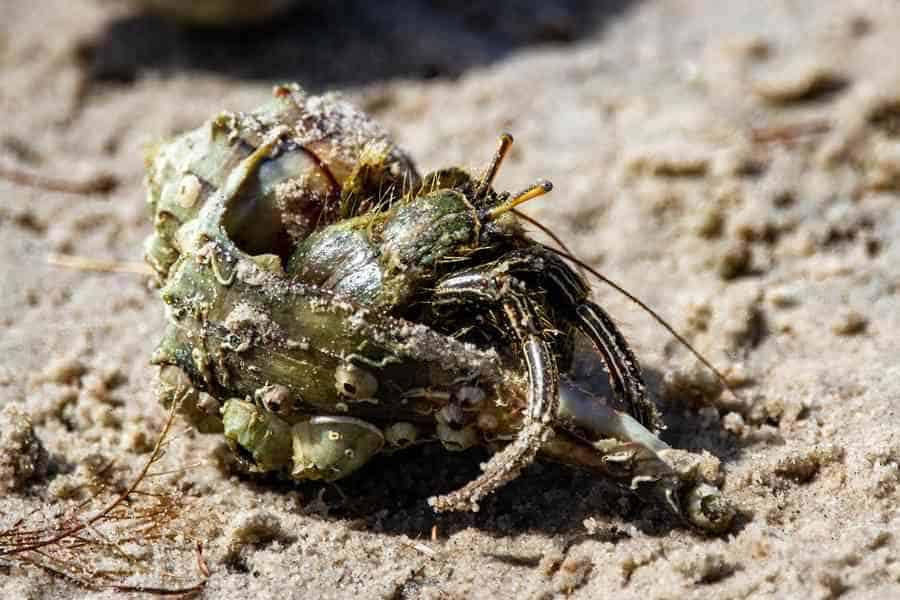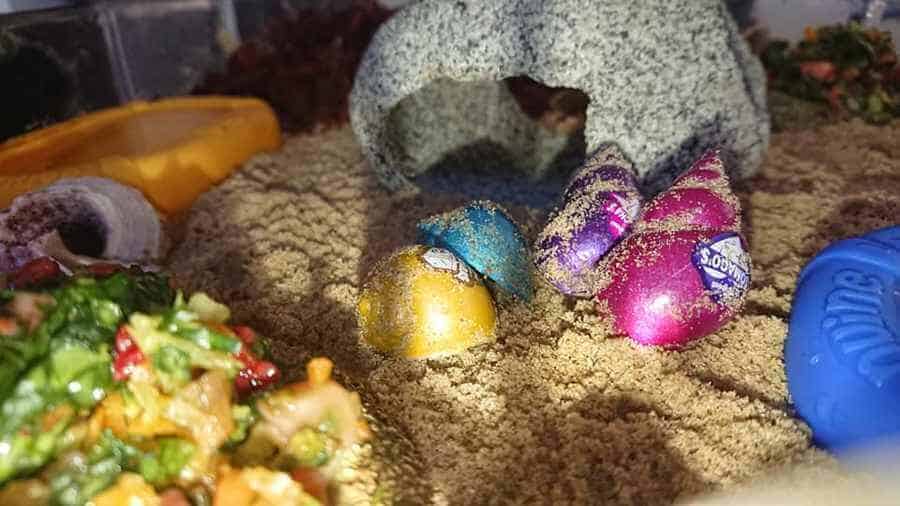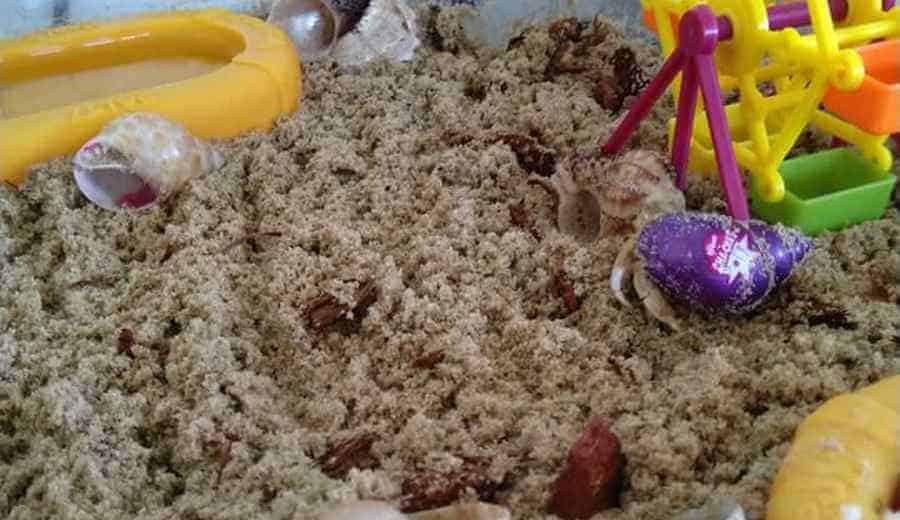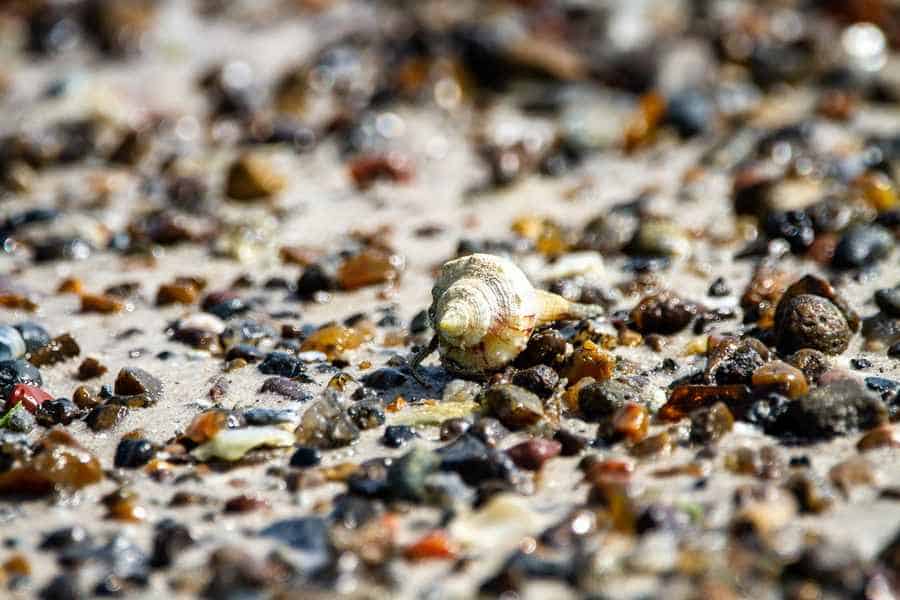Sand is a much better choice of options to choose from when deciding to have hermit crabs as pets.
The reason why sand is a better choice is that hermit crabs have originated from a sandy environment near beaches and over time they have moved to reside near freshwater lakes also. Both of these environments offer a sand grainy texture therefore this makes digging, burrowing down underneath easy.
Most hermit crab pet owners prefer to use sand, which can be purchased from your local pet store, or you may choose to take a bucket to their local beach and collect fresh sand to take back home and pour into their crab’s habitat or enclosure.
This is also a terrific option as if you scout along the beach foreshore area you may stumble upon beach leaves that have fallen from the nearby tree’s, fresh seaweed, shells of a variety of sizes that may be useful to put in the habitat for your crab, rocks of many sizes and fresh beach wood.

| Softer textured | Easier for the hermit to moult in |
| Part of their natural environment | Easy for the hermit to burrow within |
| Accessible from your beach or pet store | Hermits can temperature regulate better |
Do Hermit Crabs Love Sand?
You will find that your hermit crab will absolutely love the sand you bring home as they enjoy digging and burrowing down below the surface of the sand and making tunnels within for fun and exercise.
Sand is also very safe and a gentle option for your fragile hermit crabs to moult within. This process happens several times in a year, depending on the crab entirely.
The texture of sand from a beach is amazing due to the softness and the way the hermit crabs can easily burrow and secure themselves within.
They can also regulate their body temperature under the sand and when moulting, sand makes an excellent choice for helping them breathe.
Digging or crawling on the surface after a moult is simplified for the hermit crab with sand being on offer as their new claws that have survived the treacherous moult do not become caught on any rougher surface and gives the little hermit crab an easy return to the sands top layer after the moult has been a success.
One very vital tip to remember when using either store-purchased sand or sand you have taken the time to collect from the beach is it will require changing either weekly or fortnightly.

Why Do You Need To Change Your Hermit Crabs Sand?
The reason you need to change your hermit crabs’ sand out of the enclosure is due to moisture that builds up within the habitat from humidity as your enclosure has a lid and this creates the perfect temperature and humidity for your little crabs require to breathe effectively.
Your tiny little nocturnal hermit crabs also eat during the nighttime when they are awake and therefore each day these sweet little critters produce tiny pieces of feces in their sand enclosure that you may very well never spot with your own eyes.
Cleaning our pes habitat allows for a bacteria-free environment and this is especially important to maintain due to the unpredictable nature of crab who likes to moult spontaneously without any notice!
Another really important reason to change your habitat sand is due to the various fresh and organic produce you feed your crabs.
When your little hermit crab eats from the small bowl of fresh food provided daily, he or she will pull that food down from the bowl with its food claw located on its right side and devour it on the surface of the sand.
This will encourage your sand to develop a small scent, not necessarily a terrible scent, but one that if you did not ever change your crabs sand would eventually become very smelly indeed!
Your water bowls, whether they are the saltwater bowl or the fresh drinking water bowl can tip over easily when either the crab crawls into it or is burrowing beneath it.
This obviously makes the sand wet and hermit crabs prefer the drier environment.
You may opt to air-rate your enclosure each week that you do not empty and refill with sand and this also will give you a good indication of whether the sand below is wet or dry.

Using Gravel In Your Hermit Crabs Enclosure
Let’s assume you cannot access sand as you do not reside near a beach or have a local pet store that supplies any manufactured sand. What can you do about having a hermit crab as a pet?
You can purchase gravel from your local pet store, or search online and also substitute this idea for crushed coral, dried, crushed leaves, small pebbles from a river, the soil you would use to pot your plants, or finely crushed wood chips.
These ideas are what some use on top of their sand hermit crab enclosures as an additive for extra play-time for their tiny pets.
- Gravel can be bought at your pet store
- Gravel is an alternative to sand
- Gravel is a rougher texture than sand
- Gravel can also be an ideal molting scenario
You may wish to add a pile of finely crushed wood chips in a corner and some of your little hermit crabs may opt to sleep within this pile for security and safety.
Tips For Using Gravel With Hermit Crabs
Gravel can be very rough on some hermit crabs’ legs. It takes a great deal of effort and strength for the little crabs to roam around their enclosure getting themselves to and from the saltwater bowls, fresh water bowls, and of course, their food bowl.
Using gravel in your enclosure also disallows the small pets to be able to burrow easily and if one of your hermit crabs has slightly injured their claws or legs, this would make the idea of tunneling under the sand more difficult for them when wishing to have some sleep.
Fine coral or finely chopped wood chips would be a much happier alternative that your little creatures would like to live within, and these can be obtained either at your local beach where very fine coral can be located down by the water’s edge on a low tide or at your local pet store.
If you opt to use gravel in your hermit enclosure, there are some very important things you need to remember and do differently than if you chose to use sand.
Due to the en-even surface that gravel provides when you tip it into your clean enclosure, this bares a difficult situation for how to stabilize your two water bowls and your one food bowl.
There is no way to smooth gravel out even if you try!
Positioning your bowls as best as you can on the surface is recommended, however, you will have to check your enclosure more often as the bowls may tip over easier and this creates a real issue with the water bowls being able to pour down through the gravel air pockets and towards the bottom of the habitat.
Your little pets won’t enjoy this happening if they have taken all their energy trying to burrow through the hard gravel only to discover they have reached water!
As much as crabs require water of both the salt and freshwater variety, they much prefer to have it contained in two separate bowls over finding it mixed together and in one big pile below.
Food can also get stuck and lodged within the gravel and if it is not located early, it will eventually become stuck to the gravel texture, creating bad smells and extra moisture along with the enclosure needing extra cleaning out on a more regular basis than sand.

Sand Is The Best Choice Of Habitat Substrate
- Sand
- Potting soil used for gardening
- Finely chopped wood chips
- Forrest or garden bedding
- Crushed coral
- Gravel
- Small river pebbles
Our Best Tip Change The Sand Keep It Clean
Remember that your small, miniature pet is a fragile and delicate creature and this needs to be taken into serious consideration when deciding whether to use sand or gravel or any of the in-between options we have discussed here today.
More Pages On Hermit Crabs
Before keeping a hermit crab from the beach, it is important to be fully prepared for having a hermit crab at home. This includes having a proper tank, all the supplies it needs, and proper food....
When people think of pets, they generally think of cats or dogs, even guinea pigs or fish. However, pets truly can come in a variety of animals. This particularly includes the hermit crab. Hermit...

